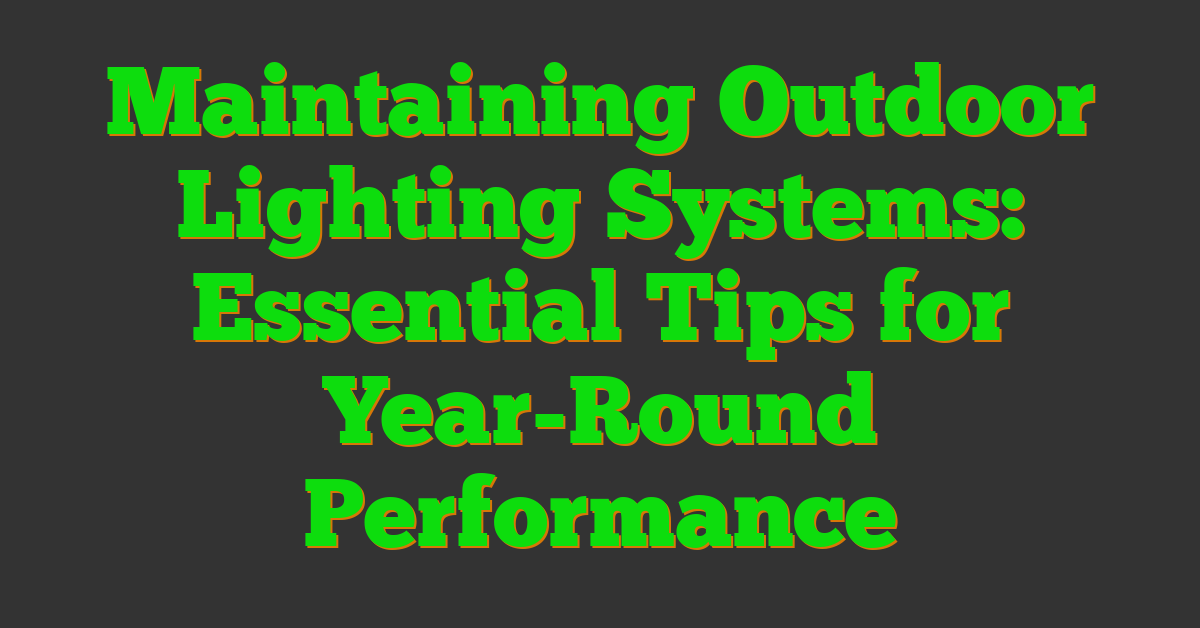Outdoor lighting can truly transform your home’s ambiance and boost its safety after dark. I’ve always enjoyed how the right lights highlight my garden paths and create a welcoming entrance for guests. But keeping these systems running smoothly takes a bit of attention.

Regular maintenance not only prevents unexpected outages but also extends the life of your fixtures. From swapping out bulbs to checking connections, there are simple steps you can take to ensure your outdoor lighting stays bright and reliable. Let’s explore some easy tips to keep your lights shining beautifully all year round.
Importance of Maintaining Outdoor Lighting Systems
Maintaining outdoor lighting systems ensures home safety and enhances curb appeal. Properly functioning lights deter potential intruders by illuminating entry points and reducing dark areas around the property. Regular maintenance prevents unexpected outages, keeping pathways and driveways visible and safe during nighttime.
Consistent upkeep extends the lifespan of lighting fixtures and bulbs, leading to cost savings by minimizing frequent replacements. Energy efficiency improves as well-maintained systems operate optimally, reducing electricity consumption and lowering utility bills. Additionally, maintaining outdoor lighting preserves the aesthetic appeal of the home by highlighting architectural features and landscaping, creating a welcoming environment for residents and guests.
Types of Outdoor Lighting
Choosing the right outdoor lighting enhances both functionality and aesthetics. I explore various lighting options to help you make informed decisions.
LED Lighting
LED lights offer energy efficiency and long lifespan. They use up to 80% less energy than traditional bulbs and last approximately 25,000 hours. Available in diverse colors and styles, LED fixtures suit pathways, gardens, and security lighting. Their durability withstands harsh weather conditions, reducing the need for frequent replacements.
Solar Lighting
Solar lights harness renewable energy, reducing electricity costs. They feature photovoltaic panels that charge during daylight, eliminating wiring complexities. Ideal for areas without easy access to power sources, solar fixtures include garden lanterns, motion sensors, and string lights. Proper placement ensures maximum sunlight exposure, enhancing their performance and reliability.
Maintenance Best Practices
Maintaining outdoor lighting systems requires regular attention. Following best practices ensures longevity and optimal performance.
Regular Cleaning
I clean my outdoor lights monthly to remove dust and debris. Removing buildup prevents reduced brightness and overheating. I use a damp cloth for fixtures and a soft brush for hard-to-reach areas. For stubborn grime, mild soap solutions work effectively. Regular cleaning extends bulb lifespan and keeps lighting appearances sharp.
Inspecting and Repairing Fixtures
I inspect fixtures each season to identify damage or wear. Damaged wiring poses safety hazards, so I repair or replace affected parts promptly. I check for loose connections and ensure seals remain intact to prevent moisture ingress. If a fixture shows signs of rust or corrosion, I treat or replace it to maintain functionality. Timely repairs prevent outages and sustain consistent lighting performance.
Seasonal Maintenance Tips
Maintaining outdoor lighting requires adjusting care routines with each season. Here are my top tips for spring, summer, fall, and winter.
Spring and Summer Care
In spring and summer, I start by cleaning all fixtures to remove pollen, dust, and debris that accumulated over the winter. Using a damp cloth and mild soap, I ensure each light shines brightly and operates efficiently. I also inspect LED and solar lights for any damage from harsh weather and replace any faulty components. Adjusting the angles of solar panels maximizes sun exposure, enhancing energy capture. Additionally, I check wiring connections for signs of wear and tighten them to prevent overheating during warmer months. Testing motion sensors and timers ensures that security lights respond correctly during extended daylight hours.
Fall and Winter Care
As fall approaches, I prepare my outdoor lighting for colder weather by replacing any incandescent bulbs with energy-efficient LEDs that perform better in low temperatures. I clean fixtures to remove leaves and moisture, preventing corrosion and electrical issues. Inspecting all exposed wiring for cracks or fraying helps me address potential hazards before freezing temperatures set in. To protect fixtures from snow and ice, I use weather-resistant covers or relocate sensitive units indoors. Regularly checking and clearing snow from light covers ensures unobstructed illumination. Additionally, I schedule periodic inspections throughout winter to promptly tackle any issues, keeping pathways and entry points well-lit and secure despite shorter days and harsh weather.
Troubleshooting Common Issues
Even with regular maintenance, outdoor lighting systems may encounter problems. Addressing these issues promptly keeps your lights reliable and efficient.
Flickering Lights
Flickering lights can indicate underlying problems that affect performance and longevity.
- Loose Connections: Ensure all wiring connections are secure to prevent intermittent power flow.
- Faulty Bulbs: Replace bulbs with compatible types to maintain consistent lighting.
- Voltage Fluctuations: Use voltage regulators to stabilize power supply and reduce flickering.
- Weather Damage: Inspect fixtures for moisture or corrosion and repair or replace as necessary.
Electrical Problems
Electrical issues can compromise safety and disrupt your lighting system.
- Tripped Breakers: Reset circuit breakers if lights go out unexpectedly, ensuring they remain properly seated.
- Damaged Wiring: Examine external wiring for signs of wear or damage and repair promptly to avoid hazards.
- Faulty Switches: Replace non-responsive switches to restore control over your lighting fixtures.
- Inadequate Power Supply: Verify that your electrical system meets the power requirements of your outdoor lighting setup.
Upgrading Your Lighting System
Upgrading your outdoor lighting enhances both functionality and curb appeal. I focus on selecting energy-efficient LED fixtures, which use up to 80% less energy and last 25,000 hours. Transitioning to LED reduces electricity bills and minimizes maintenance frequency. For example, replacing traditional bulbs in garden paths and entryways with LED options brightens spaces more effectively while conserving energy.
I also consider integrating smart lighting controls. Smart systems allow remote operation and scheduling, providing convenience and increased security. Features like motion sensors and timers ensure lights are active only when needed, further reducing energy consumption. Implementing these controls simplifies managing multiple fixtures across your property.
Solar lighting presents another upgrade option. Solar fixtures harness renewable energy, eliminating wiring complexities and lowering electricity costs. I use solar garden lanterns and pathway lights in areas without easy access to power sources. Proper placement ensures maximum sun exposure, optimizing performance and reliability.
« Creating a Tire Planter for Your Yard: Easy DIY Guide Composting 101: Healthy Soil Basics for Sustainable and Vibrant Gardens »
When upgrading, I assess existing installations to determine compatibility with new technologies. Ensuring that new fixtures match the style and functionality of current systems maintains aesthetic consistency. I prioritize fixtures with durable materials and weather-resistant designs to withstand outdoor conditions.
| Upgrade Type | Benefits |
|---|---|
| LED Fixtures | Energy-efficient, long lifespan, low maintenance |
| Smart Controls | Remote operation, scheduling, enhanced security |
| Solar Lighting | Renewable energy, no wiring, cost-effective |
By carefully selecting and implementing these upgrades, I achieve a well-lit, energy-efficient outdoor space that enhances my home’s safety and beauty.
Safety Considerations
Ensuring safety when maintaining outdoor lighting systems is crucial to prevent accidents and electrical hazards. I prioritize the following safety measures to maintain a secure and efficient lighting setup:
- Electrical Protection
- Use Ground Fault Circuit Interrupters (GFCIs): Installing GFCIs reduces the risk of electric shocks, especially in damp areas.
- Turn Off Power: Before inspecting or repairing fixtures, I always switch off the power at the breaker to avoid electrical accidents.
- Proper Handling of Electrical Components
- Secure Connections: I ensure all electrical connections are tight and weatherproof to prevent short circuits and corrosion.
- Avoid Overloading Circuits: Using bulbs within the recommended wattage limits prevents overheating and potential fire hazards.
- Safe Tool Usage
- Insulated Tools: I use insulated tools when working with electrical components to minimize the risk of electric shocks.
- Protective Gear: Wearing gloves and safety glasses protects against accidental injuries during maintenance tasks.
- Fixture Stability
- Secure Mounting: I check that all lighting fixtures are firmly attached to prevent them from falling or becoming dislodged during storms or high winds.
- Proper Support: Using appropriate brackets and supports ensures that fixtures withstand environmental conditions.
- Regular Inspections
- Visual Checks: I perform regular visual inspections to identify damaged wires, loose fixtures, or worn-out components that need immediate attention.
- Testing Functionality: Periodically testing each light ensures that all fixtures operate correctly and safely.
- Safe Ladder Practices
- Stable Ladders: When accessing high fixtures, I use sturdy ladders placed on flat, stable ground to prevent falls.
- Spotter Assistance: Having someone hold the ladder provides extra security while I perform maintenance tasks.
- Compliance with Electrical Codes
- Adhere to Standards: I follow local electrical codes and manufacturer guidelines to ensure all installations meet safety requirements.
- Permits and Inspections: Obtaining necessary permits and scheduling inspections guarantees that the lighting system complies with regulatory standards.
By implementing these safety considerations, I maintain a reliable and hazard-free outdoor lighting system, enhancing both the aesthetics and security of my home.
Conclusion
Keeping my outdoor lighting in top shape has truly transformed my home. It’s amazing how a few simple steps can make such a big difference in both safety and aesthetics. I enjoy coming home to a beautifully lit garden and knowing that my pathways are safe and secure.
Regular maintenance might seem like a hassle, but it’s worth the effort for the longevity and efficiency of the lights. Plus it saves me from unexpected outages and extra costs down the road. Upgrading to energy-efficient options and smart controls has made managing my lights easier and more effective.
Embracing these practices has not only enhanced the beauty of my home but also provided peace of mind. I encourage you to take care of your outdoor lighting and experience the benefits for yourself.
















